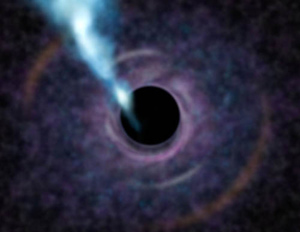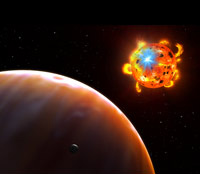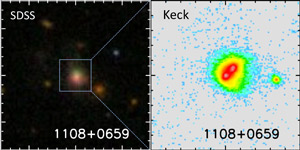Here are a few more astronomy news stories coming from this week’s AAS meeting, on top of what I already posted yesterday:
 This is pretty amazing: astronomers have determined the mass of the supermassive black hole in the center of the giant elliptical galaxy M87, and found it to be a crushing 6.6 billion times the mass of the Sun! This makes it the most massive black hole in the nearby Universe by quite a bit. And the coolest part is that they measured it by observing the speeds of the stars in the center of the galaxy as they orbit the black hole. That’s an incredibly delicate observation to make, and it took the giant Gemini telescope to do it, as well as considerable modeling of the galactic structure.
This is pretty amazing: astronomers have determined the mass of the supermassive black hole in the center of the giant elliptical galaxy M87, and found it to be a crushing 6.6 billion times the mass of the Sun! This makes it the most massive black hole in the nearby Universe by quite a bit. And the coolest part is that they measured it by observing the speeds of the stars in the center of the galaxy as they orbit the black hole. That’s an incredibly delicate observation to make, and it took the giant Gemini telescope to do it, as well as considerable modeling of the galactic structure.
M87 is the central galaxy in the Virgo cluster and is 60 million light years away (so we’re not in any danger from it). The supermassive black hole in the center of our own galaxy is 4 million solar masses, so the one lurking in the core of M87 is 1600 times more massive than ours. Yikes. Also, M87 is bright enough to be seen with a relatively modest pair of binoculars from a dark site, so next time I get a chance I’ll have to take a look. Knowing such a monster lives there will make it even better to observe.
 Red dwarf stars are the most common type of star in the Universe: smaller and cooler than the Sun, for a long time it was assumed they weren’t terribly active in any way. Decades ago, though, it was found they could emit tremendous bursts of energy, super-solar flares that put to shame what the Sun does when it’s active. Astronomers used Hubble images to look at over 200,000 red dwarfs, and caught 100 of them in the act of flaring. Some of these stars are pretty old, which is surprising, since it was thought they’d calm down with age. They might in general, but some seem able to stay peppy. My pal Nicole has more info about this on Discovery News.
Red dwarf stars are the most common type of star in the Universe: smaller and cooler than the Sun, for a long time it was assumed they weren’t terribly active in any way. Decades ago, though, it was found they could emit tremendous bursts of energy, super-solar flares that put to shame what the Sun does when it’s active. Astronomers used Hubble images to look at over 200,000 red dwarfs, and caught 100 of them in the act of flaring. Some of these stars are pretty old, which is surprising, since it was thought they’d calm down with age. They might in general, but some seem able to stay peppy. My pal Nicole has more info about this on Discovery News.
 OK, one more big black hole story. Or holes: astronomers undertook a systematic search for binary supermassive black holes, and out of 50 candidate galaxies, were able to definitively detect 16 such binary pairs.
OK, one more big black hole story. Or holes: astronomers undertook a systematic search for binary supermassive black holes, and out of 50 candidate galaxies, were able to definitively detect 16 such binary pairs.
The idea is that when big galaxies collide and merge, their central black holes will eventually merge as well. But first they have to approach each other, go into mutual orbit, and over millions or hundreds of millions of years, merge into one bigger black hole. A few binary pairs have been seen before, but this is the largest such group found systematically. The astronomers picked 50 galaxies with features that might indicate binary black holes (such as double sets of features typically seen in spectra taken of galaxies with supermassive black holes in them), and found 16 such pairs. The other galaxies without binary black holes may have something else going on in their cores; perhaps the black hole is producing beams of energy that are interacting with matter around them, for example.
What this means is that bigger telescopes with higher resolution will be able to separate even closer binaries, and eventually we’ll be able to sample a population of them all the way up to when they’re about to actually merge and combine into a single black hole. That must happen in all big galaxies, and has happened in ours perhaps many times!
Image credits (respectively): Gemini Observatory/AURA illustration by Lynette Cook; NASA, ESA, and G. Bacon (STScI); S. G. Djorgovski, H. Fu, et al., Caltech